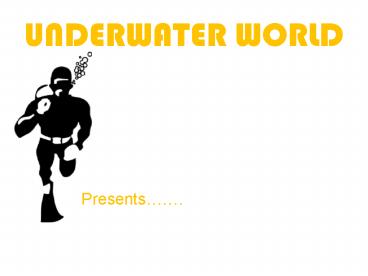UNDERWATER WORLD - PowerPoint PPT Presentation
1 / 25
Title: UNDERWATER WORLD
1
UNDERWATER WORLD
- Presents.
2
(No Transcript)
3
The PADI Master Scuba Diver Programme
- The Black Belt of Scuba Diving
- Expand and enhance your scuba skills and
knowledge - Become one of the privileged
- Highest level a diver can reach
- Denotes superior achievement and proficiency
4
Requirements
- PADI Advanced Open Water Diver
- (or equivalent)
- PADI Rescue Diver (or equivalent)
- Any 5 PADI Specialty ratings
- Proof of 50 Logged dives
- A sense of adventure, exploration,
- excitement and a passion for diving
5
Which Specialty?
Cavern Diver, Deep Diver, Equipment Specialist,
Night Diver, Research Diver, Search and
Recovery Diver, Underwater Navigator, Underwater
Photographer, Wreck Diver, Boat Diver, Drift
Diver, Dry Suit Diver, Multilevel Diver,
Underwater Naturalist, Peak Performance
Buoyancy, Underwater Videographer, Distinctive
Specialist (varied).
It depends on what you want to achieve For
example, if you live in Johannesburg and dive
locally, how about Altitude Diver Specialist and
Discover Enriched Air Nitrox?
6
PADI recommends that you
- Try out the most popular
- specialty diving activities
- Increase your underwater
- experiences
- Explore new environments
7
We recommend that you try the following .
- Enriched Air Diver
- Deep Diver
- Wreck Diver
- Underwater Navigator
- Peak Performance Buoyancy
- Night Diver
- Rescue Diver
- Underwater Photographer
8
A Few Facts signing on, timeand popular
specialities .
- Chat to your instructor who is a diving education
specialist, they will advise you how to embark
on this programme - Completion can take anything from several
months to several years. You will decide the
pace of your Master Scuba Diver programme - Many divers choose to complete the 50 dives and
several speciality courses on an away trip. - Which is the most popular speciality
course? the one that appeals to you!
9
Start today with Discover Enriched
Air Nitrox
- Course Overview
- Can be run during the Open Water Diver Course or
any other. - Knowledge Development
- Enriched Air Dive Planning
- Care for Equipment
- Hazard Management
- Use and application of Enriched Air
- Course Completion allows.
- You to dive on a 32 O² mix within the no-stop
limit of the air RDP or air based computer - Max 30m/100ft
- Indirect Supervision of PADI Professional who is
Enriched Air Certified.
10
Rescue Diver
- Course Overview
- Crucial step in expanding knowledge and
experience beyond recreational level. - Rescue divers learn to look after themselves and
to consider safety well being of other divers. - Training prepares you to prevent problems and if
necessary, manage dive emergencies using a
variety of techniques. - Five knowledge development sessions
- Rescue skills
- Practical rescue scenarios
- Exam with 50 questions
- Curriculum is performance based.
11
Enriched Air Diver
- Course Overview
- Planning, organisation, procedures, techniques,
problems and hazards of enriched air diving - Analyse Enriched Air Cylinders content
- Extend your no-stop limits beyond the normal
limits of diving with air - Learn what colour coding, stickers and tags
Enriched Air cylinders should have - Risk factors when diving with Enriched air -
Nitrox
12
Deep Diver
- Course Overview
- Planning, organisation, procedures, techniques,
problems and hazards of deep diving - Risk factors and decompression-tables review
- Safety stops and emergency decompression
procedures - Special equipment, decent lines and
buoyancy-control considerations - Procedures for flying after diving and high
altitude - Orientation to recompression chambers
13
Wreck Diver
- Course Overview
- Planning, organisation, procedures, techniques,
problems and hazards of wreck diving - The preparation and use of lights, air supplies,
special equipment, penetration lines and reels - Limited visibility diving techniques and
emergency procedures
14
Underwater Navigator
- Course Overview
- Planning, organisation, procedures, techniques,
problems and hazards of underwater navigation - Methods of estimating distance underwater
- Natural navigation techniques
- Using underwater patterns
- Dive site relocation techniques
- Compass navigation techniques
15
Underwater Search and Recovery
- Course Overview
- Planning, organisation, procedures, techniques,
problems and hazards of underwater search and
recovery diving - Limited visibility diving and underwater
navigation techniques - Proper techniques and safety considerations for
object location, including the use of various
search patterns, lines and reels - Proper technique and safety considerations for
recovery of - objects using various lifting
- devices
16
Night Diver
- Course Overview
- Planning, organisation, procedures, techniques,
problems and hazards of night diving - Proper procedures for buoyancy control,
navigation and communication - Use of dive lights and buddy-system techniques
- Disorientation
- Emergency procedures
- Orientation to nocturnal aquatic life
17
Underwater Photographer
- Course Overview
- The planning, organisation, procedures,
techniques, problems and hazards of underwater
photography diving - Photographic principles, composition, film types,
flash/available light photography and camera
handling techniques - The preparation, care and maintenance of
photographic equipment
18
Equipment Specialist Course
- Course Overview
- Theory, principles and operation of diving
equipment - Routine, recommended care maintenance
procedures and equipment storage - Common problems with equipment and recommended
professional maintenance procedures - Simple suggestions for comfortable equipment
configurations and an - introduction to new
- equipment
19
Boat Diver Course
- Course Overview
- Planning, organisation, procedures, techniques,
problems and boat diving hazards - Boat Diving etiquette storage of personal
equipment, personal conduct and considerations
for care of the boat. - Basic common boat diving terminology
- Specific Boat Diving Laws and/or ordinances
- Overview of emergency/safety equipment needed
on-board private diving vessels
20
Drift Diver Course
- Course Overview
- Planning, organisation, procedures, techniques,
problems and hazards of drift diving - Special equipment, floats, lines and reels
- Proper procedures for buoyancy-control,
navigation and communication. - Site selection and overview of aquatic currents
causes and effects. - Techniques for staying close to a buddy or
together as a group.
21
Underwater Naturalist Course
- Course Overview
- Planning, organisation, procedures, techniques,
problems and hazards of diving in different
aquatic environments - A basic overview of major aquatic life groupings
(kingdoms and phyla) - Factual information to dispel myths about
potentially dangerous aquatic life - An overview of basic aquatic life interactions
and associations - Responsible human interaction with aquatic life
- Diving techniques used to help preserve bottom
dwelling aquatic life and minimize aquatic life
disturbances
22
Peak Performance Buoyancy Course
- Course Overview
- Peak Performance Buoyancy fundamentals
- Use of PADIs Basic Weighting Guidelines
- An opportunity to polish buoyancy control beyond
the Open Water Diver level
23
Diver Propulsion Vehicle (DPV) Course
- Course Overview
- Planning, organisation, procedures, techniques,
problems and hazards of diving with a underwater
propulsion vehicle - Equipment considerations including but not
limited to, battery care, maintenance and
precautions - Procedures for determining a turnaround point,
vehicle failure, runaway motor, descents
ascents and avoiding propeller entanglement - Techniques for avoiding harming fragile aquatic
life. - Techniques for entering and
- exiting the water with a DPV
24
Project AWARE Speciality Programme
- Course Overview
- The Project Aware philosophy about protecting
worldwide aquatic ecosystems - The importance of and interdependent nature of
worldwide aquatic ecosystems - Pertinent issues concerning the environmental
status of worldwide aquatic ecosystems, including
fisheries concerns, coastal zone management and
marine pollution. - The status of specific, critically degraded
marine environments. - Suggestions and information about specific
actions that may help to conserve worldwide
aquatic ecosystems.
25
- Increase your diving experience, fun and explore
new environments. Sign up today
For more information or to book your place on our
next course please call Underwater World Tel
031-3325820 or 3375586/30 Fax 031-3375587
E-mail dive_at_underwaterworld.co.za. Physical
Address 251 Point Road, Durban, 4001 Yours in
diving The UNDERWATER WORLD Team For further
information on our Scuba Diving Courses ENTER
HERE, or complete our online BOOKINGS FORM and
we will contact you!
Images courtesy of Peter Driessel and PADI































